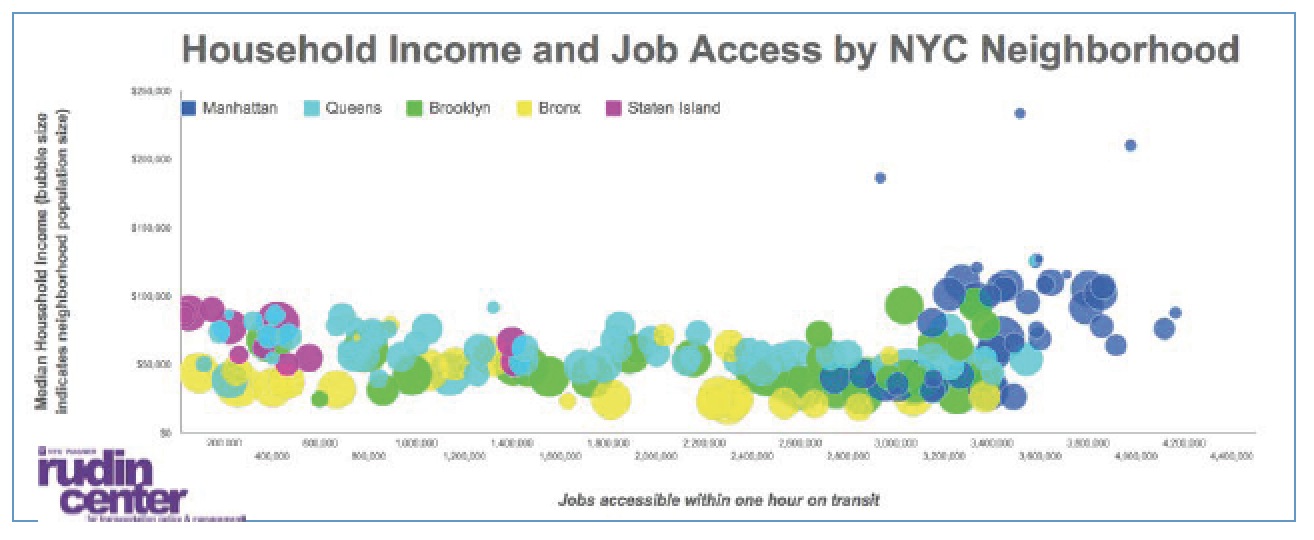NYU WAGNER RUDIN CENTER FOR TRANSPORTATION POLICY & MANAGEMENT
EXECUTIVE SUMMARY
Although public transit provides access to jobs throughout the New York City region, there are actually substantial inequalities in mobility. By focusing on the neighborhood level, the NYU Rudin Center for Transportation has identified communities that are substantially underserved by the public transportation system.
The Rudin Center ranked New York City’s 177 neighborhoods according to the number of jobs accessible from the neighborhoods by transit, within 60 minutes and completed by 9:00 a.m.on a Monday morning. The number of jobs accessible in this timeframe ranged from 42,275 (South Staten Island) to 4,839,253 (North Chelsea). Our analysis reveals substantial variation in levels of transit access across New York affect residents’ employment levels, travel modes and incomes. Most notably, the rankings result in a swoosh-shaped relationship between transit and income: the highest incomes are connected to the areas with the most access, and low transit access still provides average incomes, because residents travel by private car rather than transit. (This chart is also available in interactive form: http://bit.ly/RudinJobAccess)
The neighborhoods appearing in the middle-third of the rankings were those with the lowest household incomes: the areas with highest accessibility prefer transit or walking, and those with the fewest transit options often commute in private vehicles. The middle third has enough transit access to commute effectively, but insufficient transit options to provide significant job opportunities, leading to the city’s highest unemployment rates and lowest incomes:
These imbalances of access perpetuate issues of income inequality and traffic congestion, limiting both economic and physical mobility for many in the city. The NYU Rudin Center for Transportation offers several recommendations to mitigate access disparities, including:
Increase transportation options in New York City.
New York City works well when residents can easily switch between transportation modes, so they can always travel to their destinations using primary or secondary modes. Specifically, on- demand intelligent buses could help fill the gaps in transit service. Using web-based summoning of vehicles, a more flexible and efficient system can link riders from home to transit hubs or workplaces. In Red Hook, Brooklyn, for example, a smart shuttle bringing residents to Downtown Brooklyn would reduce travel times to Midtown Manhattan from 50 to 28 minutes, making 89,498 more jobs available within one hour on transit. This tool could also be used to significantly improve Access-A-Ride paratransit systems, which are currently run by phone reservations and are extraordinarily costly for the City to manage.
Improve roadways with Bus Rapid Transit.
As previously recommended by a study from Pratt Center for Community Development, Bus Rapid Transit should be developed on several corridors in New York City. Woodhaven Boulevard in Queens is an ideal location, with 30,000 bus riders daily and a width that allows sufficient space for a protected bus lane. Bus speeds would likely be increased by 30 percent, providing thousands of New Yorkers with vastly improved access to more job opportunities through multiple connections to subways along the route.
Maximize the efficiency of the existing transportation system.
Although New York’s landscape makes it extremely difficult to build new infrastructure, the Metropolitan Transportation Authority should seek to improve upon existing resources, including unused tracks and building out simple transfers. In particular, the CityTicket should be extended to weekday usage, allowing New York City residents to ride commuter rail at a discount. In Norwood, in the Bronx, residents’ commutes would be reduced from 48 to 33 minutes to Midtown Manhattan when using Metro-North, making 527,819 more jobs available.
Encourage remote work.
Due to advances in telecommunications tools, many information-based jobs can be conducted remotely. If policymakers incentivize distributing the workforce (to places like neighborhood office centers and co-working spaces), employees will reach their places of work more easily, the productive workday will be expanded without the hassle of commuting, workers in more isolated locations will have access to more job opportunities, and crowding on transit will be reduced. Approximately four percent of New Yorkers work from home; that number may increase significantly with the advent of the new citywide wi-fi system.
By focusing on underserved areas of the New York City job market, we can implement new policies and services to increase economic opportunity for New Yorkers, and ensure the transportation system is fully leveraged to connect workers with jobs. These improvements will benefit all New Yorkers’ access to job opportunities and economic mobility.
Download full version (PDF): Mobility, Economic Opportunity and New York City Neighborhoods
About the NYU Wagner Rudin Center for Transportation Policy & Management
wagner.nyu.edu/rudincenter
The Rudin Center for Transportation at NYU’s Wagner School aims to strengthen our understanding of all modes of transportation through research, public forums, and educational programs. The Center draws upon faculty, students, and visiting scholars at NYU.
Tags: New York City, NYC, NYU Wagner Rudin Center for Transportation Policy & Management, Rudin Center








 RSS Feed
RSS Feed